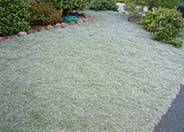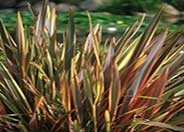
Common name:Dymondia, Rock Ditty
Botanical name:Dymondia margaretae
This foliage is gray/green/silvery; it is a very dense, mat forming ground cover. It tolerates drought, cold, salt spray and poor soils. It's deep rooted and produces small, inconspicuous yellow flowers. Rock Ditty is great for use in between stepping stones or pavers.
Maintenance Tips
Dymondia margaretae is a low, perennial ground cover that forms a very dense mat of silver-green foliage capable of choking out other plants. It stays lower than 2" tall and can spread out to 15". This is a very drought tolerant plant, but it grows much faster and thrives with regular irrigation. The most common maintenance issue with this plant is weeding. It is naturally slow-growing when it is getting established, which allows seeds and other creeping plants to emerge between the plants. Using a pre-emergent can be very effective in keeping weed seeds from germinating, but creeping plants will have to be removed by hand. Regular weeding can keep your Dymondia looking and performing its best. Once the plant has filled in, there is less space for weeds to grow, so the maintenance will decrease over time. Once established, it can creep and grow around the base of other plants. Prune it away from other plants to prevent them from being choked out.
Common name:Blue Hibiscus
Botanical name:Alyogyne huegelii
This round shrub will grow about 10' tall and wide and has medium-sized green leaves with lavender blue flowers that bloom all year.
Maintenance Tips
Alyogyne huegelii is a large, free-form shrub with large, dramatic purple flowers that resemble hibiscus. Also known as Blue Hibiscus, this shrub prefers full sun and well-drained soil. To keep this plant looking and performing its best with very little maintenance, make sure to plant it in a sunny location and give it 8-10' of space to reach its full maturity. It is a woody shrub so as it grows and the canopy becomes dense, the interior branches will no longer see sunlight and will no longer grow leaves. To keep the shrub free-form and blooming throughout, it is best to use the thinning method of pruning and make some of the cuts back to the main trunk to allow the sun to reach the interior of the plant. Shearing the plant is never a good idea because all of the blooming potential is at the tips of the branches. Shearing will take off all of the blooms and will cause the plant to send out excessive growth and the natural shape of the plant will be forever lost. This plant is susceptible to aphids and other soft-bodied insects. Instead of using pesticides to control these pests, it would be better to use a hard jet of water or even bring in ladybugs to treat the infestation. That will ensure that the beneficial insects and birds can continue to enjoy the flowers.
Common name:Rainbow Warrior New Zealand Flax
Botanical name:Phormium tenax 'Rainbow Warrior'
New Zealand Flax is an excellent accent plant for the garden. Evergreen leaves are long, narrow, and grow upright. Clusters of flowers grow on spikes above the foliage in late spring and summer. 'Rainbow Warrier' grows 3'-4' tall, 5'-6' wide. Leaves are darker salmon, turning cream as they age. Foliage turns deep red in winter.

Common name:Catmint
Botanical name:Nepeta X faassenii
Nepeta faassenii makes soft, gray green, undulating mounds that are 1.5' high when blooming. The small leaves are attractive to cats. This perennial has lavender blue flowers in late spring and early summer.

Common name:Common Garden Canna
Botanical name:Canna X generalis (assorted varieties)
These lilies will grow anywhere from about 2-5' tall and have large dark green or bronzy green leaves with flowers that come in a variety of beautiful colors and that bloom spring to fall.Needs protected location and extra care to survive in Las Vegas and desert regions.
Photographer: GardenSoft
Physical weed control, including mulching, or hand removal protects the watershed from harmful chemicals.
Mulching and adding compost to soil can minimize evaporation and help soil absorb and store water.
Remove irrigation water and fertilizer from areas where you don't want weeds to grow.